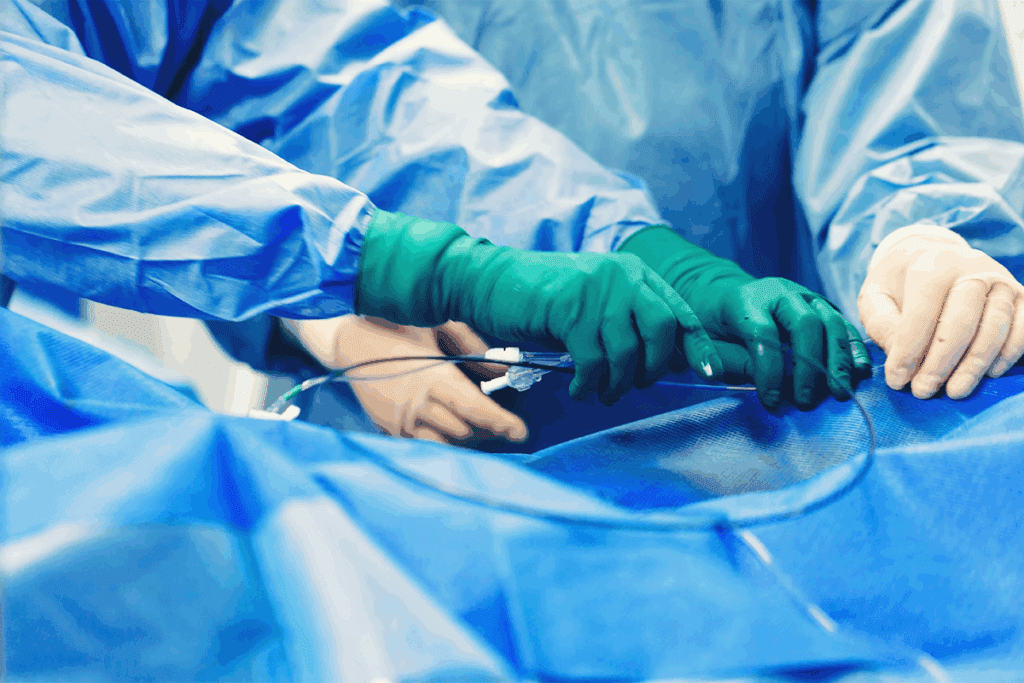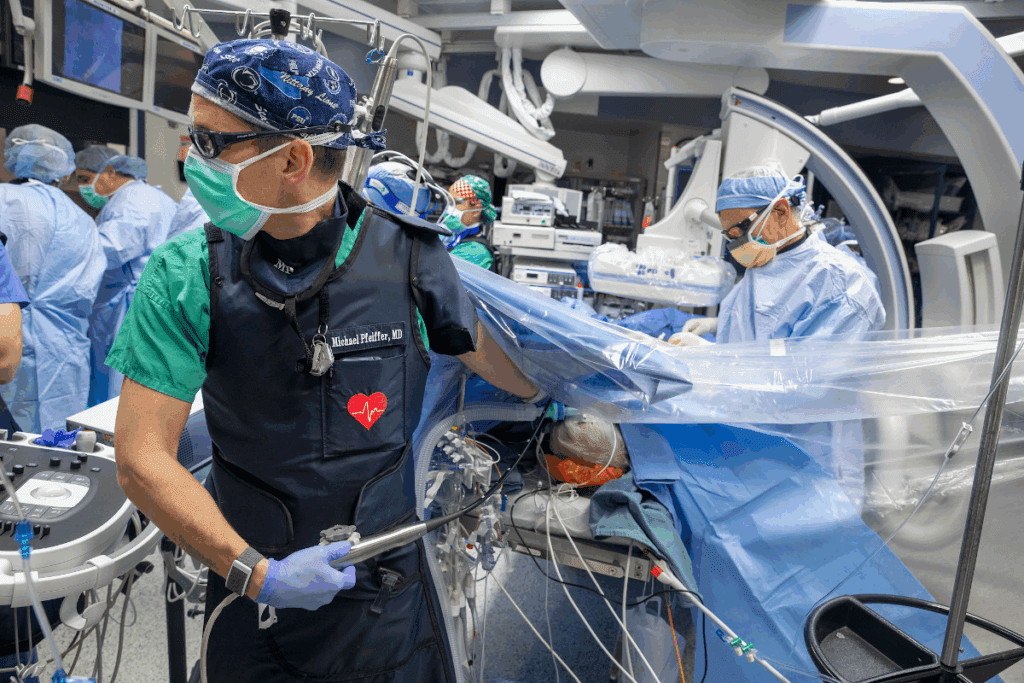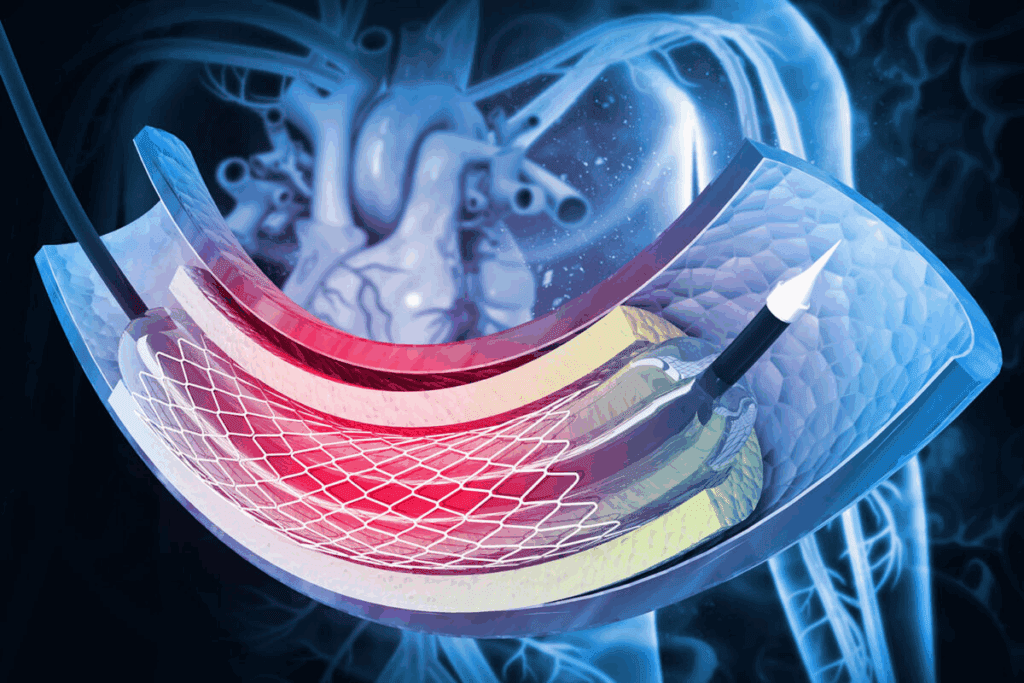Last Updated on October 30, 2025 by mcelik

Recovering from angioplasty and stent procedures requires careful attention to physical activity. At Liv Hospital, we emphasize the importance of choosing the best exercise after angioplasty to ensure a safe and effective recovery.
Supervised exercise is both safe and highly beneficial. Cardiac rehabilitation programs help patients regain strength, confidence, and improve overall heart health. Recommended activities for the best exercise after angioplasty include walking, swimming, and low-impact cycling. These exercises promote gradual recovery while minimizing stress on the heart.
By following guidance on the best exercise after angioplasty, patients can enjoy a smoother recovery, regain mobility, and support long-term cardiovascular health under professional supervision.

Angioplasty and stent placement involve several key steps. Angioplasty widens narrowed or blocked arteries. A stent is placed to keep the artery open.
A catheter with a balloon tip is used in angioplasty. It is guided to the narrowed artery section. The balloon is then inflated to push plaque against the artery walls, improving blood flow.
A stent, a small, mesh-like tube, is often used to support the artery walls and prevent re-narrowing. The procedure is done under local anesthesia, and patients are usually awake.
“The advancements in angioplasty and stenting have revolutionized the treatment of coronary artery disease,” says a leading cardiologist. “These procedures have become indispensable in restoring blood flow to the heart and improving patient outcomes.”
After the procedure, the body starts to heal, and the artery repairs itself around the stent. It’s common for patients to experience some discomfort or bruising at the catheter site, but these symptoms typically resolve within a few days. The stent helps keep the artery open, reducing the risk of future blockages.
Patients are advised to rest and avoid strenuous activities after the procedure. Monitoring by healthcare professionals is key during this phase to manage any complications and assess the procedure’s success. Most patients can return to normal activities within a week. This time can vary based on individual health and the procedure specifics.
As we progress through recovery, understanding the role of exercise becomes more important. Exercise is key to recovery and maintaining long-term cardiovascular health.

Recovering from heart procedures like angioplasty and stent placement greatly benefits from exercise. It’s not just a suggestion; it’s key to healing. It boosts overall health and heart function.
After procedures like angioplasty and stenting, exercise is very beneficial. It makes the heart work better, lowers the chance of more heart problems, and improves your overall health.
Exercise is great for the heart. It improves blood flow, makes the heart muscle stronger, and helps move oxygen and nutrients. It also helps control heart disease risks like high blood pressure, diabetes, and obesity.
Research shows that exercising after a stent can greatly improve results. A study in the Journal of the American Heart Association found that active patients had fewer heart problems.
| Benefits of Exercise | Description | Impact on Heart Health |
| Improved Circulation | Enhances blood flow and oxygen delivery | Reduces risk of further cardiac events |
| Strengthened Heart Muscle | Increases cardiac output and efficiency | Improves overall heart function |
| Risk Factor Management | Helps manage blood pressure, diabetes, and obesity | Decreases the likelihood of heart disease progression |
In conclusion, adding exercise to your life after angioplasty and stent procedures is essential. It helps in a successful recovery and keeps your heart healthy. Always talk to your cardiologist to create a fitness plan that’s right for you.
After getting an angioplasty and stent, knowing when to start exercising is key. Everyone recovers differently. Several things affect when you can start moving again.
Most doctors tell patients to avoid hard work for a few weeks after the procedure. Usually, people can get back to normal in 1 to 2 weeks. But this time can change based on your health, the procedure’s complexity, and your doctor’s advice.
Key milestones in the recovery timeline include:
Before starting any exercise after angioplasty and stent placement, watch for signs that you’re ready. These include:
If you notice any bad symptoms, talk to your healthcare provider before exercising.
Talking to your cardiologist before starting any exercise is very important after angioplasty and stent procedures. They can give advice tailored to your situation, procedure details, and health.
During your consultation, be sure to discuss:
By following these guidelines and talking to your cardiologist, you can safely start exercising after angioplasty and stent placement. This supports your recovery and heart health.
After angioplasty, a gentle walking program is key to recovery. It boosts heart health and overall well-being. Walking is low-impact, easy on the joints, and fits all fitness levels.
Walking is great for those recovering from angioplasty and stent placement. It improves blood flow and strengthens the heart. It also helps manage weight, reduces stress, and boosts physical function.
Key benefits of walking include:
To get the most from your walking, progress slowly. Start with short walks and gradually increase distance and intensity. Keep an eye on your heart rate and adjust your pace.
Tips for progressing your walking program:
Here’s a sample walking schedule to help you get started:
| Week | Duration | Frequency | Intensity |
| 1 | 10 minutes | 3 times | Gentle |
| 2-3 | 15 minutes | 4 times | Moderate |
| 4-6 | 30 minutes | 5 times | Brisk |
It’s important to check the intensity of your walks. Use a heart rate monitor or the “talk test” to see if you’re in the right zone. For moderate exercise, you should be able to talk, but with some effort.
Swimming and water exercises are great for healing after angioplasty and stent placement. They help your heart, muscles, and joints. Plus, they’re easy on your joints.
Water exercises after angioplasty and stent procedures are very beneficial. Water makes movements easier and less stressful. Swimming and walking in water improve your heart health and fitness.
Key benefits include:
There are many water exercises good for recovery. These include:
Start slow and gradually get more intense and longer as you get stronger.
Water exercises are great, but safety is key. Always talk to your cardiologist before starting any new exercise, including swimming.
| Safety Tips | Description |
| Pool Temperature | Make sure the pool water is comfy (78°F to 82°F) to avoid heart stress. |
| Supervision | Swim with a friend or tell someone where you are and when you’ll be back. |
| Intensity | Begin with easy exercises and get harder as you get fitter. |
Swimming and water exercises are a fun way to boost your health after angioplasty and stent procedures. They help your heart and overall well-being.
After angioplasty and stent placement, low-impact cycling can boost your heart health. Cycling fits all fitness levels, making it perfect for those recovering from heart procedures.
Stationary bicycles offer a controlled setting for tracking your progress and adjusting resistance. They’re great for early recovery when outdoor cycling is tough. Regular bicycles, on the other hand, let you cycle outdoors, keeping your routine varied and engaging.
Begin with 10-15 minute, low-intensity cycling sessions after your procedure. As you get fitter, increase the time and intensity. Always listen to your body, easing into it during the recovery phase.
Once you’re comfortable, up the resistance on stationary bikes or try different terrains on regular bikes. Aim for 30-45 minute sessions as your heart health improves.
Talk to your cardiologist to create a cycling plan that’s right for you. Cycling can greatly improve your heart health and overall well-being.
Resistance training is key to getting stronger after heart procedures. It boosts muscle strength and endurance. As we recover, adding strength training helps us get back to full function.
The sit-to-stand exercise is great for building strength. It works many muscles and can be done anywhere. Here’s how to do it:
Resistance bands are easy to use and take anywhere. They’re perfect for early recovery when you can’t do much. Here are some exercises you can try:
Other bodyweight exercises are also good for recovery. Try these:
It’s important to keep getting stronger by doing more exercises. You can do this by:
Listen to your body and only add more resistance when you feel ready. Talking to a doctor or physical therapist can help you know when to move on.
| Exercise Type | Benefits | Progression Tips |
| Sit-to-Stand | Improves leg strength and balance | Increase repetitions, use slower movements |
| Resistance Band Workouts | Versatile, works multiple muscle groups | Use thicker bands, increase repetitions |
| Bodyweight Exercises | Convenient, improves overall strength | Increase difficulty, add variations |
Gentle stretching and flexibility exercises are key after angioplasty and stent procedures. They help improve mobility and reduce stiffness. As we recover, our bodies need to regain strength and flexibility to return to normal activities. Adding gentle stretching to your routine can greatly improve your well-being.
Upper body stretches are vital for keeping the shoulders, arms, and chest flexible. Simple exercises like shoulder rolls and arm circles can help reduce tension. To do shoulder rolls, stand or sit with your arms at your sides. Roll your shoulders forward and backward in a circular motion. Do this 10-15 times.
The chest stretch is also beneficial. Stand in a doorway with your hands on the doorframe at shoulder height. Lean forward until you feel a stretch in your chest and shoulders. Hold for 15-30 seconds and breathe deeply.
Lower body flexibility exercises are essential for keeping the hips, knees, and ankles mobile. Gentle stretches like hip flexor stretches and calf raises can improve flexibility and reduce stiffness. To stretch your hip flexors, stand with one hand against a wall for balance. Bend one knee and lift your foot behind you, keeping your back straight. Hold for 15-30 seconds on each leg.
For calf raises, stand on the edge of a step or curb with your heels hanging off. Slowly raise up onto your tiptoes and then lower back down. Repeat 10-15 times to improve ankle flexibility and calf strength.
Breathing techniques and relaxation exercises are important for a full recovery. Deep breathing can help reduce stress and promote relaxation. Sit comfortably with your back straight, place one hand on your belly, and the other on your chest. Inhale deeply through your nose, allowing your belly to rise while your chest remains steady. Exhale slowly through your mouth. Repeat this several times.
Progressive muscle relaxation is another technique to reduce muscle tension. Start by tensing the muscles in your toes, then release. Move up through the body, tensing and relaxing each muscle group in turn.
A tailored exercise plan can greatly improve your health and heart fitness. We focus on a personalized approach to fit your unique needs and goals.
It’s important to know your current fitness level before starting any new exercise. This means checking your health, heart endurance, and any physical limits. Consulting with your healthcare provider or a fitness professional can help find the right tools for you.
Setting goals that you can reach is key to staying motivated. Your goals should be specific, measurable, attainable, relevant, and time-bound (SMART). For instance, you might aim to walk for 30 minutes without discomfort in six weeks. Breaking down big goals into smaller steps makes it easier and more satisfying.
Tracking your progress is vital to see how your body reacts to the plan. Keeping a log of your activities and noting successes or challenges is helpful. Adjusting your plan as needed keeps you challenged and prevents plateaus.
Exercise should be a regular part of your daily routine for lasting success. You can schedule workouts at the same time each day or find ways to add physical activity to your daily tasks, like taking the stairs.
“The key to successful exercise is not to force it into your life, but to make it a natural part of your daily routine.”
Cardiac rehab programs offer a full recovery plan. They mix exercise, education, and stress management. These programs help patients get stronger, improve heart health, and lower the risk of future heart problems.
Cardiac rehab programs have a structured plan. It includes supervised exercise training, heart-healthy living education, and stress management. The exercise is tailored to fit your needs and abilities, making sure it’s safe and effective.
Education sessions teach about nutrition, managing medications, and lifestyle changes for heart health. Stress management might include relaxation exercises, meditation, and counseling.
Supervised exercise is key in cardiac rehab. It offers many benefits for those recovering from angioplasty and stent procedures. Healthcare professionals guide patients in safe physical activities that improve heart health and overall well-being.
Supervised exercise also allows for ongoing monitoring and adjustments. This ensures patients are challenged but safe during their recovery.
The right time to start cardiac rehab after a stent varies. It depends on your health and your doctor’s advice. Usually, patients start within a few weeks after the procedure, once cleared by their cardiologist.
It’s important to talk to your healthcare team. They can tell you when to start based on your situation.
Finding the right cardiac rehab program involves looking at location, program structure, and insurance. Ask your cardiologist or primary care physician for suggestions.
Hospitals and cardiac centers often have these programs. Outpatient options are also available. Look online and contact local programs to learn about their services and who can join.
As we wrap up our talk on exercises after angioplasty and stent procedures, it’s key to see how important a lifelong exercise habit is. Regular physical activity keeps our hearts healthy and boosts our overall well-being. By keeping up with exercise, we can keep the good health we got from the start and get even more benefits in the long run.
Exercise after angioplasty is more than just getting back on track; it’s about living a healthier life. We urge you to make exercise a big part of your daily life. Find activities like walking, swimming, or cycling that you like and can keep up with for a long time. This way, you’re moving towards a healthier, more active life.
Adding exercise to your daily routine improves your heart health and makes life better overall. Start with achievable goals and keep track of your progress to stay excited. Building a lifelong exercise habit takes dedication, but the benefits are huge.
You can start exercising a few days to a week after the procedure. But always check with your cardiologist first. They will tell you when it’s safe to start based on your recovery.
Good exercises include walking, swimming, and low-impact cycling. Also, gentle stretching and resistance movements are great. They help your heart and aid in recovery.
Yes, cardiac rehab is highly recommended. It offers supervised exercise and education. It helps you recover and improve your heart health.
No, you must talk to your cardiologist before starting any new exercise. They will ensure you’re ready and suggest the best activities for you.
Recovery time varies, but most people can get back to normal in a week or two. But it may take several weeks to fully recover and do more strenuous activities.
It’s rare for a stent to move after placement. But it’s important to follow your doctor’s instructions. Also, attend follow-up appointments to check the stent’s function.
Walking is great for your heart and circulation. It’s a low-impact exercise that’s perfect for starting after angioplasty and stent placement.
Yes, make sure the water is comfortable when swimming. Avoid extreme temperatures. Also, watch how your body reacts to the activity.
Start with short walks and gradually increase the duration and speed. Always listen to your body and follow your cardiologist’s advice.
Cardiac rehab usually starts a few days to a week after the stent. But the exact timing depends on your condition and your cardiologist’s advice.
Ask your cardiologist or healthcare provider for recommendations. You can also search online or check with local hospitals and healthcare facilities that offer cardiac rehab services.
Subscribe to our e-newsletter to stay informed about the latest innovations in the world of health and exclusive offers!
WhatsApp us